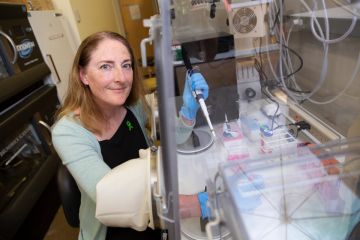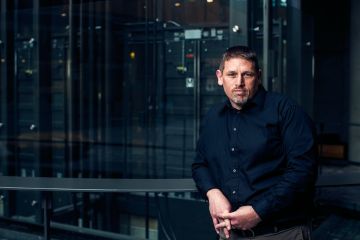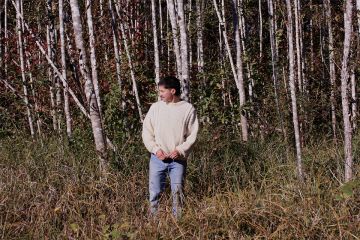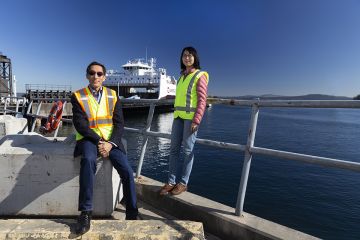Creating Alternative Energy for a Remote Community
What do you do if you live in a remote community that has only one power source and it suddenly stops working? That’s the question the University of Victoria’s Institute for Integrated Energy Systems (IESVic) is trying to answer in a two-year, $30,000 study sponsored by the Ministry of Energy and Mines.
The Huu-ay-aht First Nations community near Bamfield, a remote coastal village located on the southwestern coast of Vancouver Island approximately 150 km from Victoria, is ideally suited to such a study. As well, if the Huu-ay-aht can generate energy locally, it will create needed jobs and provide more autonomy.
In order to understand the current and future energy needs of the Huu-ay-aht, UVic mechanical engineering graduate student Christina Ianniciello spent last summer living in the village.
“I organized many ‘energy activity days’ to help residents become familiar with energy options,” says Ianniciello. “We cooked hot dogs using solar energy, went on field trips, and participated in scavenger hunts. It was a chance for me to meet members of the community and talk about their plans for the future. It was also a chance for the residents to get to know me too.”
What she discovered is that the village has a problem with the reliability of the power it receives from B.C. Hydro via a line from Port Alberni. Currently, it experiences as many as 30 outages annually averaging nine hours each. It’s also interested in creating jobs and using energy more efficiently in its homes. This is especially timely as the main village of Ana’cla is being rebuilt and relocated to a higher location because of the possibility of damage from another tsunami. It was severely damaged in the 1964 tsunami that also struck Port Alberni. The entire Ana’cla tribe, save for one person, was wiped out by a tsunami in the 1700’s.
“As a result of Christina’s work we’ve come up with some ideas that have the potential to benefit the Huu-ay-aht economically and allow them to have consistent power,” says Dr. Peter Wild, IESVic’s acting director. “For example, electrical storage may be one way for the community to ride out power outages. We’re also looking at using wind, micro-hydro and biomass energy.” The IESVic team will present its recommendations to the Huu-ay-aht in the summer of 2005.
“The timing of IESVic’s study is perfect,” says Tom Happynook, one of the hereditary chiefs and co-chief treaty negotiator for the Huu-ay-aht First Nations. “For the past six years we’ve been trying to build better homes for our families which are more appropriate to their needs, as well as attempting to overcome the deficiencies of the current energy source from B.C. Hydro. This project and IESVic’s recommendations regarding our energy network, sustainable integrated energy sources and energy efficient homes will help provide more rationale which we can take to the Department of Indian Affairs. Currently we are negotiating with the department about relocating our village to higher ground in case another tsunami hits.”
IESVic is a Canadian leader in the promotion and development of creative energy alternatives through original research. Founded in 1989, IESVic’s areas of expertise include fuel cells, cyrofuels, energy systems analysis and energy policy development. For more information visit www.iesvic.uvic.ca/.
The Huu-ay-aht First Nations community near Bamfield, a remote coastal village located on the southwestern coast of Vancouver Island approximately 150 km from Victoria, is ideally suited to such a study. As well, if the Huu-ay-aht can generate energy locally, it will create needed jobs and provide more autonomy.
In order to understand the current and future energy needs of the Huu-ay-aht, UVic mechanical engineering graduate student Christina Ianniciello spent last summer living in the village.
“I organized many ‘energy activity days’ to help residents become familiar with energy options,” says Ianniciello. “We cooked hot dogs using solar energy, went on field trips, and participated in scavenger hunts. It was a chance for me to meet members of the community and talk about their plans for the future. It was also a chance for the residents to get to know me too.”
What she discovered is that the village has a problem with the reliability of the power it receives from B.C. Hydro via a line from Port Alberni. Currently, it experiences as many as 30 outages annually averaging nine hours each. It’s also interested in creating jobs and using energy more efficiently in its homes. This is especially timely as the main village of Ana’cla is being rebuilt and relocated to a higher location because of the possibility of damage from another tsunami. It was severely damaged in the 1964 tsunami that also struck Port Alberni. The entire Ana’cla tribe, save for one person, was wiped out by a tsunami in the 1700’s.
“As a result of Christina’s work we’ve come up with some ideas that have the potential to benefit the Huu-ay-aht economically and allow them to have consistent power,” says Dr. Peter Wild, IESVic’s acting director. “For example, electrical storage may be one way for the community to ride out power outages. We’re also looking at using wind, micro-hydro and biomass energy.” The IESVic team will present its recommendations to the Huu-ay-aht in the summer of 2005.
“The timing of IESVic’s study is perfect,” says Tom Happynook, one of the hereditary chiefs and co-chief treaty negotiator for the Huu-ay-aht First Nations. “For the past six years we’ve been trying to build better homes for our families which are more appropriate to their needs, as well as attempting to overcome the deficiencies of the current energy source from B.C. Hydro. This project and IESVic’s recommendations regarding our energy network, sustainable integrated energy sources and energy efficient homes will help provide more rationale which we can take to the Department of Indian Affairs. Currently we are negotiating with the department about relocating our village to higher ground in case another tsunami hits.”
IESVic is a Canadian leader in the promotion and development of creative energy alternatives through original research. Founded in 1989, IESVic’s areas of expertise include fuel cells, cyrofuels, energy systems analysis and energy policy development. For more information visit www.iesvic.uvic.ca/.
-- 30 --
Media contacts
Dr. Peter Wild (Mechanical Engineering & IESVic) at (250) 721-8901 or pwild@me.uvic.ca
Christina Ianniciello (IESVic) at (250) 721-6532 or iannicic@uvic.ca
Maria Lironi (UVic Communications) at (250) 721-6139 or lironim@uvic.ca
In this story
Keywords: creating, alternative, energy, remote, community




